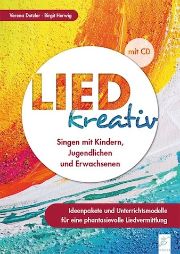Working imaginatively with songs
In "Lied kreativ", Verena Dotzler and Birgit Herwig show a wide range of possibilities for developing and creating songs at basic level.

Creative song is a book for music lessons in the lower school up to 4th grade and shows in an easy-to-understand way how to work with songs. The first step is to learn the songs. The authors offer a variety of methodical and activity-oriented approaches, whereby the musical characteristics of each song form the nucleus for the development. The second step is the arrangement of the song, and this is where the great quality of Song creative. Because the songs are not only sung, they are danced, staged and accompanied with Orff instruments. The arrangements are easy to put into practice. And the authors are rightly proud of this: They deliberately offer suggestions for improvisation so that the children can contribute their own ideas. Incidentally, this approach is entirely in line with the "creative processes" that are prominently postulated in Curriculum 21.
Creative song is divided into three parts, starting with the methodology of teaching songs: although the teaching models are varied, the work on the song follows a clear, structured concept. It starts with breathing and voice training exercises, followed by teaching the lyrics and melody. The instructions are precise and you can feel the experience and expertise of the trained music teachers (EMP). The vocal exercises are embedded in stories and pictures that appeal to the children's senses and take them with them, true to the maxim: "Working on a song means playing with it." The chapter "A possible way to create your own lesson concept" outlines how to do this in a planned way, with the following didactic instruction particularly appealing: "The teacher should guide the activities as non-verbally as possible." In fact, music lessons often suffer from too many verbal instructions and explanations instead of direct guidance through musical actions. Participants are not activated by talking, but by doing, moving and singing. In this way, they are in medias res right from the start, the senses are addressed simultaneously and there is no need to translate from the head to the body.
The idea packs, the second part of the teaching material, offer a colorful bouquet of sound, dance and scenic suggestions for developing and arranging the songs. The welcome song Swing invites you to dance with walking sticks - Come in, into the vaudeville of the thirties! - for soloists, dancers and audience. Also the Song with Andalusian sounds is embedded in a scenic play (Torero), while the vocal percussion liven up the ragtime. The Orff instruments are included as standard in the idea packages. But not only! Baking utensils are needed in the Land of milk and honey, in the African Aye kerunene cloths lead through the mirror dance, the sound colors made of paper underline the Autumn song.
While the idea packs present loose lesson plans, the third part of the volume contains fully developed lesson models. For example Whyba: The spoken song with humorous lyrics can be sung in canon or accompanied by body percussion. A scenic game with a coconut sets the mood for the song, beach activities such as collecting shells loosen up the body, accompanied by rumba music. The word "ko-kos-nuss" is used to generate breathing and vocal exercises that work with the vowels and activate the diaphragm. Parts of the melody are packed into actions and stories ("the coconut has unfortunately been left lying on a palm tree") and prepare for challenging interval leaps. The entire song is repeated several times in variations: speaking the text, showing gestures silently, singing and re-singing sections of the song. Stepping and clapping accentuate the shifts in emphasis in the lyrics, interrupted by improvised "beach poses".
After the song has been worked out and practiced, it is now performed. Singers improvise body percussion in pairs over the rhythm of "Coconut-Coconut-Rumba". The group chooses an impromptu motif and imitates it. Now one half sings, the other accompanies with body percussion and, if it works, even in canon. The playback recording and the piano accompaniment on the enclosed CDs provide support.
Conclusion: Well thought-out ideas, variable implementation. Well done!
Verena Dotzler, Birgit Herwig: Lied kreativ. Singing with children, young people and adults. Idea packs and teaching models for imaginative song teaching, book with 2 CDs, order no. 943, € 29.90, Fidula, Koblenz








